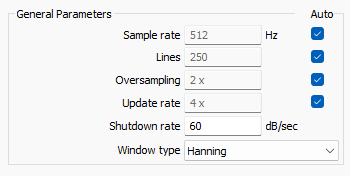An aerospace customer faced an issue with their random vibration test where the vibration fell below the minimum abort limits. Per the client-provided test specifications, an out-of-tolerance value at even one frequency was constituted as a test failure. The customer replicated the issue on multiple units tested on the same axis, verifying the repeatability of the test setup.
The customer’s goal was to meet the client-provided test specifications, so they set out to find a solution within the test profile.
Degrees of Freedom
 First, the customer reduced the degrees of freedom (DOF) value between the first and second units with no improvement. The DOF is an averaging parameter that helps characterize the random power spectral density (PSD). A lower DOF uses fewer frames of data to generate a PSD. Lowering this value reduces variability, thus improving stability.
First, the customer reduced the degrees of freedom (DOF) value between the first and second units with no improvement. The DOF is an averaging parameter that helps characterize the random power spectral density (PSD). A lower DOF uses fewer frames of data to generate a PSD. Lowering this value reduces variability, thus improving stability.
Lines of Resolution
 The customer then decreased the lines of resolution to a short update interval with no improvement. The lines of resolution help determine the spacing of analysis points on the PSD. A higher lines value creates a more accurate PSD but requires more samples. Lowering this value simplifies the analysis, thus improving stability.
The customer then decreased the lines of resolution to a short update interval with no improvement. The lines of resolution help determine the spacing of analysis points on the PSD. A higher lines value creates a more accurate PSD but requires more samples. Lowering this value simplifies the analysis, thus improving stability.
However, too few lines of resolution result in a scenario similar to under-sampling because the distance between analysis points is too far. The change in frequency for the PSD increases between points, reducing the precision of the control.
iDOF
![]()
At this point, the customer’s best option was to use the iDOF® software. iDOF is a statistically valid method of providing smooth lines and an in-tolerance PSD in a brief testing period.
For this customer, iDOF would clean up the estimation error in the PSD, smoothing out the trace and potentially allowing them to run the test with higher lines of resolution. In turn, increasing the lines value would improve the precision of their PSD. Both these improvements would result in a better test.
DOF Calculator
Engineers can use the DOF calculator to calculate the probability of satisfying various tolerance levels. It gives engineers an idea of how different parameters (number of lines, maximum frequency, etc.) affect the probability of satisfying a particular tolerance level for a random test.
Featured Software


